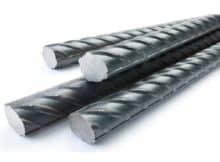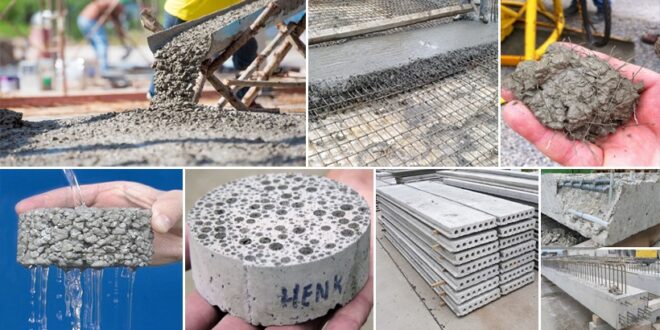What Is Foundation?
Foundation is the lowest portion of a structure which transfers the load into the supporting soil. The main purpose of the foundation is to distribute the total weight of the superstructure over a large area of soil. Various types of foundations are described below which are used in construction.
Purpose Of Foundation
Foundations are mainly provided for the following purposes:
i) To distribute the load of the structure on a bigger area so that the intensity of load does not exceed the safe bearing capacity of the underneath soil.
ii) To distribute the load underneath soil uniformly and thus prevent unequal settlement of the foundation.
iii) To provide a leveled and hard surface for the super-structure to be built over it.
iv) To increase the stability of the structure against sliding, overturning, or any other forces like wind, rain, etc.
v) To prevent lateral movement of the supporting material to ensure the safety of the structure is not at risk.
Types Of Foundation
Foundations can be classified into two general categories:
- Shallow Foundation.
- Deep Foundation.
1. Shallow Foundation
When the depth of the foundation is equal to or less than its width, it is called a shallow foundation. In this type of foundation, the foundation part is situated instantly below the lowest part of a structure (see the below image).
The total load of the structure is distributed over a horizontal area at shallow depth below the ground level. In simple words, if a foundation is constructed at reasonable depth then it is a shallow foundation.

Classification Of Shallow Foundation
- Spread Footings.
- Combined Footings.
- Mat Or Raft Foundation.
- Grillage foundation.
- Eccentrically loaded footings.
1. Spread Footings
In this type of foundation, a spread is provided under the base of the wall or column which is known as footings, and foundations with such footings are known as spread footings.
Spread is provided to distribute the load of the structure to the soil over a wider area so that the safe bearing capacity of soil does not exceed.

Types Of Spread Footings
i) Wall Footing: In this type of foundation, courses of bricks (normally 100 mm depth) provided below the super-structure by giving 50 mm outward offsets on either side of the wall.
ii) R.C.C Footing: RCC footings are used when the masonry wall is subjected to a very heavy load and the bearing capacity of the soil is very low.
In this type of footing, generally, 3 cm thick layer of concrete is proved before RC footing is constructed over it. In RC footings reinforcing bars are provided. RCC column footing may be square, rectangular or circular.
Combined Footings
Combined footing consists of a common footing provided to two columns which may be either rectangular or trapezoidal.

Strip Footing: This type of footing distributes the weight of a load-bearing wall across the area of the ground. The footing usually has twice the width of the load-bearing wall, sometimes even wider.
Strap Footing: In strap footing, the outer and inner column is connected by a strap beam, which does not transfer any load to the underlying soil.
2. Raft Foundation
Raft foundation consists of a dense reinforced concrete slab which covers the total bottom area of the structure. This type of foundation is provided in the soil with low bearing capacity where structural loads are heavy.

3. Grillage Foundation
This type of foundation is suitable when the load transferred by a wall or column is exceptionally heavy and soil bearing capacity is very low. Deep excavations are also excluded from this foundation. Grillage foundations are two types:
- Steel grillage foundation &
- Timber grillage foundation.

4. Eccentrically Loaded Footing
In this type of foundation, the distribution of pressure on the soil remains uniform. However, the foundation may be subjected to an eccentric load under the following situation:
i) When a column or wall is located at the property line, its foundation is restricted and can not be extended beyond the property line, resulting in eccentric loads on the foundation.
ii) Cantilever balconies, brackets, etc attached to the walls or columns inducing bending moment and thus resulting in eccentric loading on the foundation.

Eccentric loadings cause an uneven distribution of pressure on the underlying soil of the foundation. If the eccentricity is small, it should be ensured that the maximum intensity of pressure should not exceed the safe bearing capacity of the soil.
And if eccentricity is large the wall or column may overturn. In this case, the following two methods can be adopted to ensure the stability of the wall/column without infringing on the area beyond the property line.
- a) Offsetting the footings
- b) Proving strap footings.
2. Deep Foundation
A deep foundation is a type of foundation in which the foundation is placed at a deeper depth below the ground level. The depth of the foundation is much greater than its width.

Deep foundation can be further classified into three categories:
- Pile Foundation.
- Cofferdams.
- Caisson Foundation.
1. Pile Foundation
Pile foundation is a type of foundation where a slender member of wood or concrete or steel is inserted into the ground for transferring the load of a structure.
The load is transferred to a stronger stratum by friction or by bearing. This type of foundation is generally used in the situation of low bearing capacity of the soil or there is a layer of weak soil at the surface.

Read – When To Use Pile Foundation
Classification Of Pile Foundation
Classification Based On function:
Bearing Piles
Bearing piles are driven through the soft overlay soil and their bottom rests on the hard bed structure. The end bearing piles act as vertical columns or piers.
They create a medium to transfer the structural load through piles to the hard underneath stratum. The soft soil also provides lateral support to the piles increasing the soil bearing capacity.
Friction Piles
When overlay soil is for large depths and it is not possible to rest the bottom end of the pile on the hard bed, the load is carried by developing friction between the surrounding soil and surface of the piles.
The load-carrying capacity of friction piles can be increased by increasing the diameter, grouping of piles, driving the pile for larger depth, and making the pile surface rough.
Sheet Piles
These types of pile foundations are used to act as retaining walls. Sheet piles are used
- To construct retaining walls in docks or other marine works.
- To Retain the sides of foundation trenches.
- To protect the erosion of river banks.
- To confine the soil to increase its bearing capacity.
- To isolate foundations from surrounding soil.
- To protect foundations from erosion by sea or river.
Anchor Piles
These types of piles provide anchorage against horizontal pulls and thrusts.
Batter Piles
These piles are driven inclined to resist horizontal and inclined forces more suitably.
Fender Piles
These types of piles made of timbers and mainly protect the berthing ships from damage. They also protect the concrete deck or waterfront structures from the impact caused by ships.
Compaction Piles
These piles are driven through granular soil to increase the bearing capacity of weak soil.
Classification based On Material
- Timber piles.
- Concrete Piles.
- Steel Piles.
- Composite piles.
- Sand piles.
2. Cofferdams
A Cofferdam is a temporary structure that excludes the water from a given site to enable the construction on a dry surface.

Classification Of Cofferdams Based On Material
- Earthen Cofferdam.
- Rock-fill Cofferdam.
- Single-walled cofferdam.
- Double-walled cofferdam.
- Crib Cofferdam.
- Cellular Cofferdam.
3. Caisson Foundation
Caisson is a watertight structure made of wood, steel, or reinforced concrete that excavates for the foundation of bridges, piers, etc. This type of foundation is mostly used in bridge pier construction and other structures that require foundation underneath water.

Types Of Caissons
- Open Caisson.
- Box Caisson.
- Pneumatic Caisson.
I hope you now have enough knowledge about different types of foundation. If you have any questions let me know in the comments.
Also Read
Types Of Bridge Foundation
What Is Grillage Foundation
Types Of Footings In Construction
For More Updates like our Facebook Page and join our Telegram Channel.





nice it is perfect .but also strip foundation is another types of shallow foundation
i am minhaj ansari and i am civil engineer so i want me a fresher job
plesse inform me
Nice information
I am a assistant engineer in civil and mechanical so I want a fresher job plz help me.
i am civl engineer you can find jobs for me
i am civi engineering studen i need praticle expriance please help me
good information
Kindly send me your updates
I complete my civil engg so i wana job ..
Help me
I’m a graduate of Building Technology pls I need job I would be to work with you thnks
Excellent keep it up.